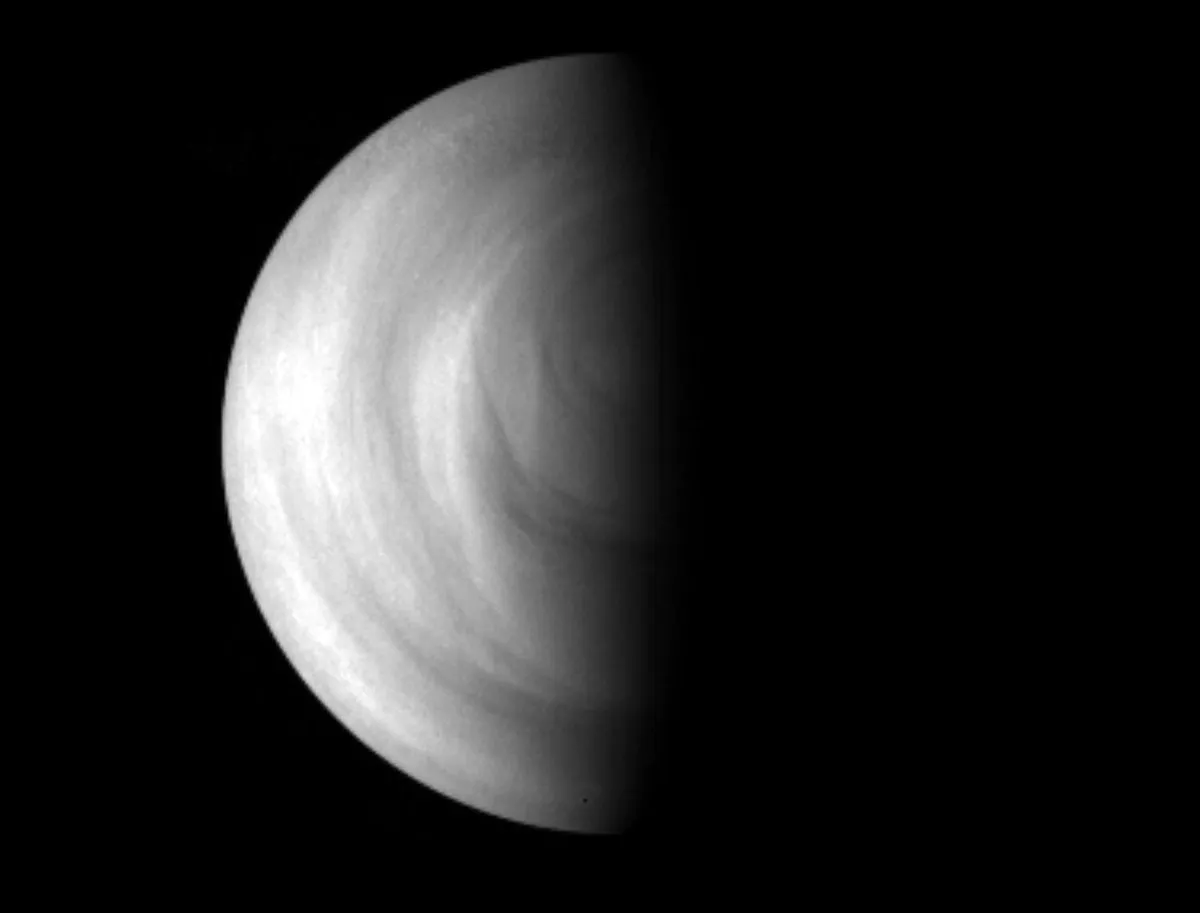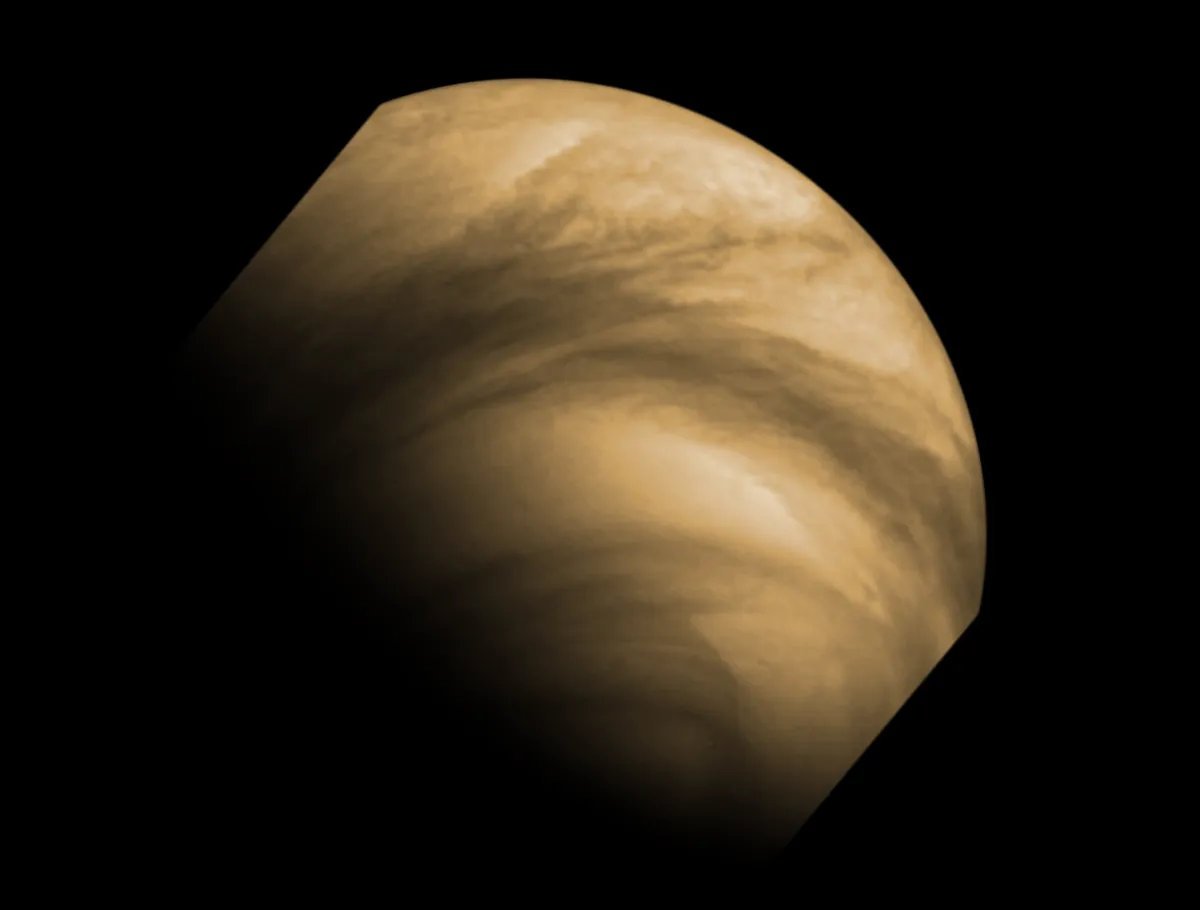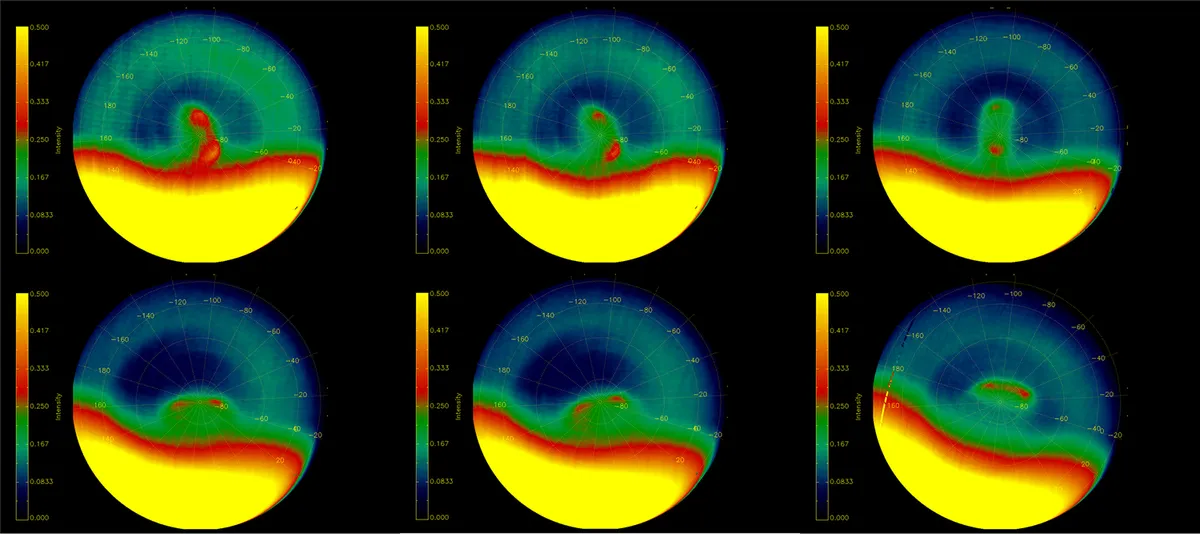On the face of it, Venus is nothing like Earth. It has no seasons and takes 243 Earth days to rotate just once. It has a massive atmosphere composed chiefly of carbon dioxide rather than nitrogen. Its clouds contain droplets of sulphuric acid. And yet, the European Space Agency’s Venus Express mission showed that Venus may be more like Earth than anyone could possibly have imagined.
“Venus and Earth are twins, but they were separated at birth,” says Fred Taylor, a Venus Express scientist from the University of Oxford.
By studying Venus, planetary scientists hope they’ll be able to help our own environment, by finding out more about how Earth’s climate works.
Venus Express arrived at Venus on 11 April 2006, and began its mission to observe the second planet from the Sun. After several mission extensions, the spacecraft eventually lost contact with Earth in late 2014.
Here are 10 secrets that Venus Express revealed about our mysterious, beautiful twin.
1
Greenhouse effect
Venus Express discovered that a rare isotope of carbon dioxide strengthens the greenhouse effect. In 99% of carbon dioxide molecules, the nucleus of each oxygen atom is composed of eight protons and eight neutrons.
But in 1%, one of the oxygen atoms has 10 neutrons instead of eight. This destabilises the molecule, allowing it to vibrate in complex ways and store more energy.
Venus Express scientists saw the fingerprint of the molecule in their data. Since Venus’s atmosphere contains 250,000 times more carbon dioxide than Earth’s, the effect is catastrophic – the surface of Venus is hotter than a kitchen oven.
2
Venus Express detects a sudden brightening
On 13 January 2007, Venus Express’s instruments spotted two-thirds of the southern hemisphere suddenly brightening. The brightening came from a layer of haze at high altitude, composed of highly reflective aerosol (airborne) particles.
The feature disappeared just as quickly a few days later when the aerosols coagulated, clearing the haze. Scientists believe the brightening happened when something triggered new aerosols to form at a furious rate in the Venusian atmosphere.
As yet, no one knows what started this amazing transformation, but solar activity has not been ruled out. Some scientists believe that particles given off by the Sun can cause aerosols to form when they hit the atmospheres of planets.

3
Meltdown temperatures
If you could holiday on Venus, you’d feel the heat. It takes about 120 Earth days for the Sun to cross the sky, so it hangs over the same spot on Venus’s equator for weeks on end. This produces roasting temperatures of around 500°C.
The atmosphere is so thick that most of the Sun’s energy never reaches the surface – it’s absorbed by gas 100km above the ground.
As heat streams in, the gas breaks up into rolling pockets known as convection cells, like milk boiling in a pan.“It’s as if the whole region is boiling,” says Venus Express scientist Wojciech Markiewicz of Germany’s Max Planck Institute.
Previously, it was thought the convection cells were 200km across. If so, they’d reach down to the surface, disrupting the expected pattern of still air above the ground.
But Venus Express has shown that they’re about 20–30km. At this size, they’re probably confined to the middle of the atmosphere, leaving a stable layer beneath.
4
Atmospheric glow
Molecules of oxygen and carbon dioxide glow in the atmosphere of Venus. In carbon dioxide, the glow is produced when a molecule absorbs and re-emits a photon of light from the Sun.
This happens quickly, so ‘airglow’ from carbon dioxide is seen only on the daytime side of the planet.
But there’s also a faint glow on the night side. This is caused by stray oxygen atoms joining together and releasing energy.
By studying both kinds of airglow using Venus Express, planetary scientists deduced more realistic temperatures of around –40°C in the upper atmosphere.
They also used the movement of the airglow to track high-altitude winds on Venus, revealing them to be very strong.
5
Volcanic activity
There is one secret that Venus is keeping from us for a while longer: whether or not there are active volcanoes on its surface.
“The contribution of volcanoes to the atmosphere could be enormous. Not knowing leaves a huge hole in our understanding of the climate,” says Fred Taylor, a Venus Express scientist from the University of Oxford.
If they are there, volcanoes could be contributing to the atmosphere by belching gases that alter its composition.
To find out, Venus Express used its Visible and Infrared Thermal Imaging Spectrometer (VIRTIS) to peer at the surface through infrared ‘windows’ in the clouds, looking for heat from active lava flows spreading across the surface.
Although scientists are quietly confident that one day they will be announcing there definitely are volcanoes on Venus, for now this beautiful planet is keeping them guessing…

6
Evaporating planet
Venus is gradually losing its atmosphere to space. Its atoms are being robbed by the solar wind, a stream of charged particles from the Sun that are bombarding the planet.
Once gone, these atoms are lost forever, which is why Venus’s atmosphere is slowly being depleted over time.
Prior to Venus Express, scientists knew that this has probably been going on throughout the planet’s 4,000 million year history.
What they didn’t know was the composition of the escaping particles. The Analyzer of Space Plasmas and Energetic Atoms (ASPERA) instrument on Venus Express revealed the particles being stripped by the Sun are predominantly hydrogen, oxygen and helium ions.
The first two – hydrogen and oxygen – are highly significant because they are the chemical constituents of water.
So where do these ions come from? Again, it’s the Sun that’s responsible. Incoming ultraviolet radiation breaks Venus’s atmospheric water into hydrogen and oxygen – two hydrogen atoms are released for every oxygen atom.
These can then be accelerated by the solar wind clean out of the atmosphere and off into space.
The highly elliptical polar orbit of Venus Express, with its closest approach of 250–350km and its furthest reach of 66,000km, is perfect for studying the escaping particles.
ASPERA has established the composition of the departing plasma is the same ratio as water: two hydrogen atoms for every oxygen atom.
This may explain why Venus is so dry today: the combined action of the Sun’s ultraviolet rays and solar wind has gradually divested it of water.
7
Measuring the magnetic field with Venus Express
Venus doesn’t generate its own magnetic field, but a weak magnetic cloak does shield the planet. Venus Express confirmed this is produced by the Sun.
It’s carried to Venus by the solar wind, a sleet of sub-atomic particles that were once within the Sun’s atmosphere, but have since been thrown off into space.
The solar wind carries electric and magnetic fields. When they strike Venus, they drape themselves around the planet, mimicking a weak planetary magnetic field.
The magnetometer instrument on Venus Express revealed that on the night side of the planet, the configuration of this pseudo-magnetic field helps electrically charged particles in Venus’s upper atmosphere to escape.
Since it comes from the Sun, the magnetic field's strength depends on how active the Sun is at any given moment.

8
Polar vortex
NASA’s Pioneer space probe discovered a vortex at Venus’s north pole. It had a peculiar double ‘eye’ structure.
When Venus Express arrived in April 2006, it discovered a similar double vortex at the planet’s south pole.
Polar vortices are common structures and can be found at the poles of any planet with an atmosphere, even Earth. Venus’s are different because they have a double-lobed structure, like a double hurricane.
Scientists believe these features form when warm air from the equatorial regions rises and flows towards the poles. Once there, it begins to cool and sink, spiralling down and creating vortices.
“It plays an important role in balancing the atmosphere,” says Giuseppe Piccioni, who studied it using the Visible and Infrared Thermal Imaging Spectrometer instrument on Venus Express.
9
An Earth-like planet?
The fact that Venus is losing water makes scientists believe it once had much more of it on the surface.
“Venus started out much more Earth-like and then changed,” says David Grinspoon, a Venus Express scientist from the Denver Museum of Nature and Science, USA.
That’s why Venus is priceless for studying changes happening to Earth’s climate. Venus is a similar size to Earth, but its distance from the Sun, surface pressure and rotation rate make it drastically different.
But that doesn’t mean Venus and Earth have always been so unlike. Grinspoon says that Venus has suffered a major climate disaster drove it to become the arid inferno it is today. Using Venus Express, planetary scientists studied the rate at which Venus’s water is leaving the planet in order to unlock its past.
10
Lightning
The magnetometer experiment on Venus Express found lightning in the atmosphere, and plenty of it.
“There may be as much lightning on Venus as there is on Earth,” says Chris Russell at the University of California, Los Angeles, who was one of the magnetometer team.
This is a crucial discovery, because lightning drives chemical processes in the atmosphere. As electrical storms rage, they help create unusual molecules.
Lightning is key to this process because it breaks molecules into fragments. These can then bind to other molecular fragments in unexpected ways, creating molecules that could not otherwise form.
On Venus, nitric oxide formed by lightning is present in sufficient quantities that planetary scientists detected it from Earth in 2006, using NASA’s Infrared Telescope Facility on Mauna Kea, Hawaii.
Stuart Clark is an astronomy and science journalist. This article originally appeared in the April 2008 issue of BBC Sky at Night Magazine.

